|
American Association of Public Opinion Research
May 2004
Presentation at the 57th annual AAPOR conference in Phoenix, Arizona
An Assessment of Colorado Voter Attitudes
on Gay Rights Ten Years after Amendment 2
In 1992 Colorado voters passed Amendment 2, a Colorado constitutional amendment prohibiting gay rights protections. There was considerable astonishment that Colorado, with its history of moderate politics, adopted the amendment. A national boycott against Colorado was started and gay rights advocates began calling Colorado the hate state.
Polls published prior to the November 1992 election showed Amendment 2 failing (one Ciruli Associates final pre-election poll showed the amendment with a plurality for the first time in the campaign season). And the conventional political wisdom was that the amendment would not appeal to the Colorado electorate, which was characterized as politically moderate and was reasonably tolerant with a “live and let live” attitude. This paper examines survey data collected in 1993 and 2002 to examine if Colorado truly was the hate state and, if not, what factors explain voter support for the anti-gay amendment. (The slides referenced in this report are part of an attached PowerPoint presentation.)
Background
Amendment 2 banned the state of Colorado or its political subdivisions from adopting statutes, ordinances and policies to protect gays, lesbians and bisexuals (see slide 3 for ballot language). The constitutional amendment passed with 53 percent, but was immediately enjoined from enforcement. In 1996, the U.S. Supreme Court ruled it unconstitutional.
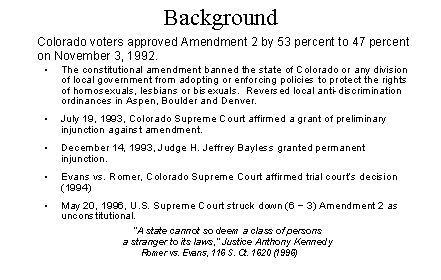
Ciruli Associates • 1490 Lafayette St., Ste 208 • Denver, CO 80218 • PH (303)399-3173 • FAX (303)399-3147 • www.ciruli.com
. . . . . . . . . . . . . . . . . . . . . . . . .
The late 1980s and early 1990s was a period of intense political activity around gay rights issues. Candidate Pat Buchanan made gay rights a major theme at the 1992 Republican convention and President Clinton’s 1993 “don’t-ask-don’t-tell” kerfuffle raised the visibility of the issue. But pro-and anti-gay rights positions were also being fought in cities and states around the country. Western states, with their easy initiative access to the ballot were especially active battlegrounds.
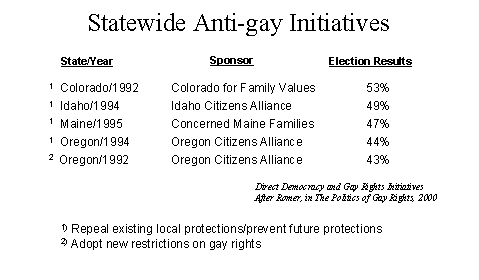
The 1992 success of anti-gay rights activists in Colorado was a surprise. The state had a politically moderate Democratic governor and was generally seen as having a mild Republican bias. Gay rights had not been a high-profile issue. Only three cities, Aspen, Boulder and Denver, had gay rights ordinances. The origin of the initiative was politically conservative Colorado Springs, located one hour south of the Denver metro area. Hence, during the 1992 election cycle it was assumed Amendment 2 would fail (see slide 5 for recent bi-partisan Colorado political history).
Data Set
Three surveys are used in this analysis. A poll done in February 1993, four months after the election, serves as the baseline for later comparisons. The poll captured voters’ continued support for Amendment 2. Question wording used in several questions in that poll were repeated in subsequent polls.
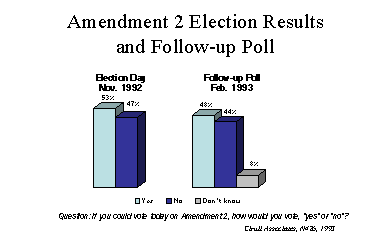
Two other Colorado voter surveys were conducted in 2002 and 2003. Each survey interviewed active registered voters drawn from a computer-generated sample of the state’s official registered voter list, then merged with phone numbers.
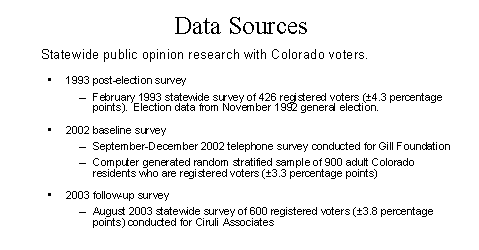
Comparisons are made to national surveys that used random digit dialing of citizens, voters and non-voters. Colorado voters are more Republican, more conservative, more Anglo, older and better educated than national random samples of citizens.
Goal & Findings
This analysis presents data on:
- comparing Colorado and national data on gay rights from legal and moral perspectives (1993 and 2002)
- comparing 1993 Colorado voter opinions on gay rights with those of voters in 2002
- measuring changes in opinions on gay rights since 2002 (post Lawrence vs. Texas and gay marriage debate)
The two key questions on legal and moral rights for homosexuals that have been repeated for more than two decades in national surveys are used in its analysis. The findings point out that Colorado was relatively progressive on gay rights in 1993 and did not have a recent tradition of extremism on social issues, yet was the first (and only) state to pass a voter-approved limitation. Subsequent analysis of elections and polling data and a review of the campaign provides insight into the dynamics that made passage possible.
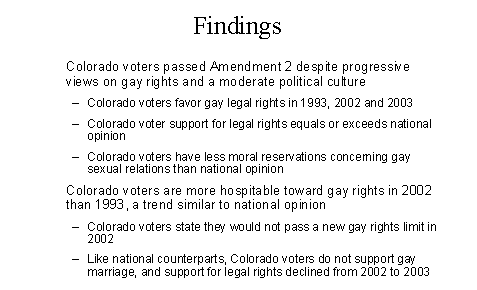
Colorado Voters Support Legal Rights for Gays and Lesbians
The 1993 Ciruli Associates poll conducted for the Rocky Mountain News immediately after the November 1992 Amendment 2 vote showed 71 percent of the public supported legal rights related to sexual relations for gays and lesbians. That support has increased in the succeeding ten years. In a statewide poll completed in 2002 (ten years after Amendment 2) 86 percent of Colorado voters said they believe homosexual relations between consenting adults in the privacy of their own home should be legal. (The question wording includes references to “consenting adults in the privacy of their own homes.”)
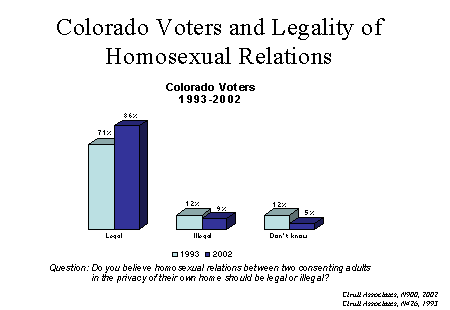
Younger Coloradans were more supportive of legal status for gay relations, than older voters, secular voters more so than religious, higher educated more so than less educated; and liberals and Democrats more so than conservatives and Republicans. This is similar to demographic differences observed in national data.
Colorado voters were strongly supportive of legal gay relations but Amendment 2 (limiting gay political rights) found a majority of voters.
Coloradans More Supportive of Gay Rights than National Counterparts
National opinion data in 1992 (the time of Amendment 2) shows that Coloradans were more liberal on legal rights for gays than the nation at-large. The Gallup poll reported much lower support nationally for gay rights (48% Gallup). Also, Colorado voters claimed to be substantially more supportive in 2002 of legal rights for gays and lesbians than did the nation.
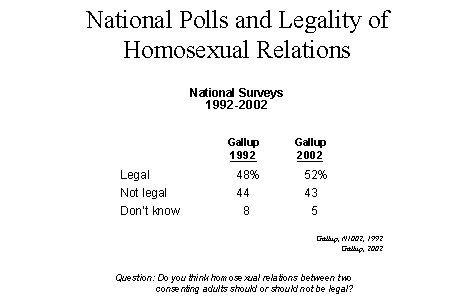
The shift toward the legality of private consenting sexual behavior for gays and lesbians in both national and Colorado data from 1992 to 2002 is statistically significant (Gallup did not report data on the question in 1993). It reflects a decade-long trend toward more accepting attitudes toward gay and lesbian rights. The current highpoint in Gallup data was reached in early 2003 when 60 percent of Americans supported legal rights.
The question wording differences account for some of the difference between Colorado and national data. The wording, “privacy of own home” adds an additional reason to support legal rights for homosexual relations. However, the difference is more than 20 percentage points. In addition, two national survey questions used the wording “in the privacy of home” in 1993 and 2003, and both showed less support than Colorado voters for gay rights. (LA Times/Gallup)
Colorado View on Morality of Gay Behavior Shows Liberal Trend
A factor in public willingness to support Amendment 2-type legislation restricting gay rights is related to the public’s moral judgment concerning homosexual behavior. Although most Colorado voters support a legal right to same-sex relations, a majority of voters in 1992 believed homosexual relations, in all cases, were morally wrong. However, in 2002, that number fell to only 36 percent. At the same time, there was an increase in those who believed homosexual relations are not morally wrong at all (41% in 2002 compared to 28% in 1993).
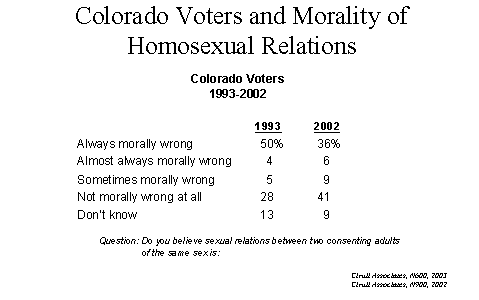
National Trend Toward Fewer Moral Reservations on
Same-sex Relations but Majority Still Says It’s Wrong
Colorado expresses more liberal sentiments than the nation in terms of the morality of homosexual relations. The National Opinion Research Center General Social Survey of 1993 shows a substantial majority (66%) of Americans believed homosexual behavior is always wrong. Nine years later, the GSS-NORC results indicated a trend toward less moral censure of homosexual behavior (53% always wrong). In both 1993 and 2002, substantially fewer Colorado voters expressed moral reservations concerning homosexual behavior.

The Colorado question wording includes the words “morally” when asking respondents if homosexual relations are wrong. It also adds the words “consenting adults.” Each term could have an impact on opinion. (The impact could be contradictory.) However, the difference in response levels remains substantial. A 1992 national poll used “morally wrong” and “consenting adults” wording and showed that 54% believe homosexual relationships are “morally wrong.” (Yankelovich, Clancy and Shuman)
Again, while Colorado voters had moral reservations in 1992, they were less socially conservative on homosexual relations than the nation-at-large.
Current Support and Opposition for Anti-Gay Rights Ballot Initiative
A majority of Colorado voters stated in 2002 that they would not support an anti-gay rights initiative like Amendment 2. Voters who were in Colorado in 1992 are more opposed than new voters; only about a third of voters favor the amendment in both cases.
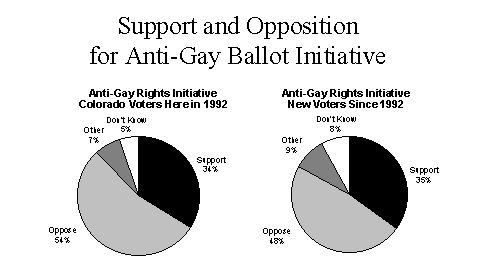
Question: Ignoring any constitutional issues, if a similar proposal was on the ballot today, that is, an intitiative that would ban Colorado's local or state governments from enacting statutes or ordinances that protected gay rights, would you vote in favor or against? Ciruli Associates N688, 2002
Question: As I mentioned, in 1992 residents voted on a ballot issue in Colorado that prevented cities, towns and the state from enacting civil rights protections based on homosexuality. It was referred to as Amendment 2, Ignoring any constitutional issues, if such a ban on gay civil rights protections was on the ballot today, would you support or oppose the ban? Ciruli Associates N212, 2002
The primary decline in support for the amendment is concentrated among those segments of the electorate that were the most supportive in 1992 (see slide 14 for demographic comparison); men (18 percentage points lower support), Republicans (22 percentage point shift) and voters with a high school education or less (24 percentage point shift).
Special vs. Equal Rights
The proponents of Amendment 2 fashioned their primary campaign message with the claim that gays and lesbians wanted “special rights” (see slide 15, script from TV advertisement). Special rights were equated with new affirmative action-type programs for gays and lesbians. By making special rights the focus, anti-gay rights advocates were able to argue that a “yes” vote was not discrimination, but a question of fairness and equal justice. They took advantage of generalized anti-government sentiments and aligned themselves with those who felt the civil rights movement had gone too far.
The issue is still troubling for voters. When asked in 2002 if gays and lesbians wanted special or equal rights, a substantial plurality of voters, 43%, said special rights. In addition, a majority of voters (53%) said gays and lesbians already have equal rights in Colorado. Only 37 percent believe they do not enjoy equal rights. Gays and lesbians have not established themselves as a group that needs protective status.
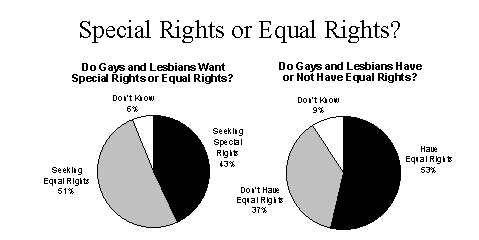
Question: In general, do you think gays and lesbians are seeking special rights or are they seeking equal rights compared to other citizens?
Question: In general, do gays and lesbians have equal rights or not have equal rights in Colorado today?
Ciruli Associates N900, 2002
Religious beliefs and behavior provides the most significant differentiation of positions on gay rights, including the equal and special rights dichotomy (see slide 17 for religion attitudes and behavior comparison). Church attendance and voter views on the origin and veracity of the Bible provide the sharpest distinctions; weekly church attendance and belief in biblical literalism are most likely to be associated with believing gays and lesbians want special rights.
Why Colorado Voters Adopted the Amendment
Amendment 2 passed for several reasons, as highlighted by the polling and analysis of election results and media content.
- The public’s moral qualms about homosexual relations makes it willing to listen to proposals that limit political freedom of action for gays. Like abortion rights, moral ambiguity allows a swing group of voters to support limits on choice.
- The issue was framed as special rights beyond equal rights. Conservative proponents were successful in tying their proposal to an effort to protect the majority from an onslaught of new special interest protections. Not only was there little public sensitivity to anti-gay discrimination but the initiation appeared to be a bar to new rights not a step back from current rights.
- The 1992 election was the beginning of the anti-tax revolution in Colorado. The nation’s most draconian tax limitation initiative was passed, presaging the 1994 national conservative movement and the Contract with America. A high presidential turnout gave Ross Perot one of his largest state vote percentages. His voters were in an angry, anti-government mood. Perot voters were more likely to vote for Amendment 2.
The amendment carried two blue-collar, working-class Democrat voting communities (Adams and Pueblo counties), bolstering an anti-gay bias associated with class distinctions regardless of partisan preferences.
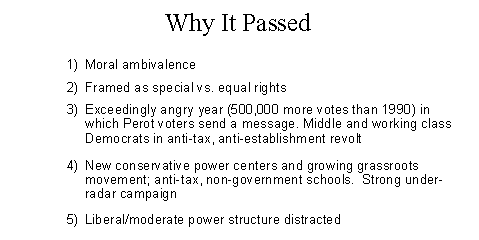
- The conservative campaign was well executed and represented a new but growing Colorado movement that was asserting increasing power in the Republican Party and in statewide ballot initiatives. Churches formed the nucleus of the campaign organization, and joined with anti-tax and home school forces to run a low-key grassroots campaign that did not become highly visible in terms of paid broadcast advertising until late in the campaign.
Much of a state’s power structure, especially the business community and media, was distracted fighting the tax-limitation initiative. The popular Democratic governor, Roy Romer, was focused on K-12 education funding initiatives (which lost in the anti-tax mood of voters).
Hence, despite attitudes that were not as hostile to gay rights as many other areas of the country, a majority of Colorado voters supported Amendment 2.
Hierarchy of Gay Rights
In the 2002 survey, Colorado voters strongly supported gay rights when they were associated with protection from job and housing discrimination. Support declined somewhat but was still relatively high for providing financial benefits for partners and serving openly in the military. Legally recognizing domestic partners and adopting children had narrow majority support and much of the support was weakly committed. Gay marriage had “strong support” from only 24% of voters and 45% from “strong” and “somewhat” supporting voters. This hierarchy of support closely follows national polling data. Support recedes for gay rights concerning children and marriage. In fact, as the gay rights debate has focused on marriage due to court decisions and the San Francisco marriage controversy, support for gay rights, in general, has declined.
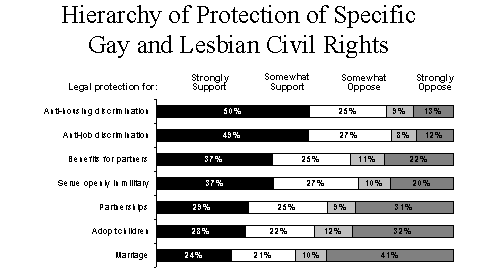
Question: Next, I'd like to focus on what, if any, civil rights should apply to gay and lesbian citizens. As I read the following list, please tell me if you strongly support, somewhat support, somewhat oppose, or strongly oppose the following rights for gays and lesbians.
Ciruli Associates, N900, 2002
Gay Marriage
The intense news cycle of gay rights coverage, which began in the summer of 2003 with the Massachusetts Supreme Court decision (Goodridge vs. Massachusetts) to recognize gay marriage and the U.S. Supreme Court striking down a Texas anti-sodomy law (Lawrence vs. Texas), coincided with a conservative shift in gay rights opinion. Although 58 percent of Colorado voters still support the view that sexual relations between two consenting adults of the same sex should be legal, the strength of the position reflects a significant drop from previous levels (86% favor legal right in 2002; 71% in 1993) (“In privacy of their home” wording was dropped to compare to national data). National opinion on gay rights also shifted during this period. Gallup reported that only 48% of Americans supported the legal status of homosexual relations in their standard question, a drop from 60% in their May 2003 poll.
Marriage is a complex political symbol for voters. It involves religion, children, legal and economic rights, gender roles and sexual morals. It is a potent mix that quickly affects voters that have some ambivalence about the right and wrongness of gay rights.
Colorado voter views on gay marriage are similar to national counterparts; 56 percent of Colorado voters oppose legally recognizing gay or lesbian marriage and only a third of voters support it. In July 2003, 87% of a Gallup national sample opposed gay marriage “be recognized by law with the same rights as traditional marriage.”
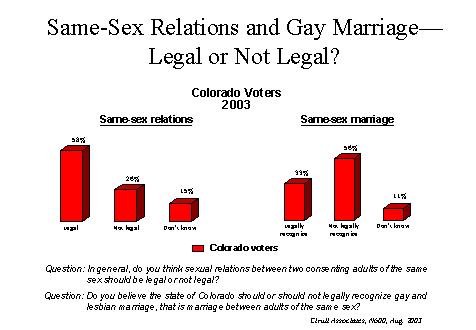
Gay rights is one of the most controversial and volatile issues in American politics. It is replacing abortion rights as the hottest issue legislators and courts are considering. The last decade produced a general increase in acceptance of gays and support for gay rights, especially related to equality of treatment in employment and housing.
Colorado has a unique and notable history with gay rights. The national anti-gay rights movement had its greatest political victory in Colorado in 1992, but it proved to be the zenith of its strength. When the U.S. Supreme Court struck down Amendment 2 in 1996 in Romer vs. Evans, the historic and often-cited decision became one of the legal platforms for Lawrence vs. Texas and subsequent state court cases. Gay acceptance grew during most of the 1990s and only recently has there been a counter reaction (due to the gay marriage controversy). Colorado voters are in the mainstream, if slightly to the left of national opinion on the subject.
. . . . . . . . . . . . . . . . . . . . . .
Ciruli Associates is a non-partisan research, communication and public policy firm providing consulting for Colorado and national organizations since 1976.
[top] [archives] [home] [send this page to a friend] |